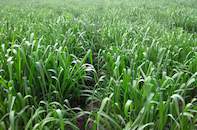
Guinea Grass
Name
Guinea grass (Panicum maximum)
Description
Guinea grass is a perennial and its leaf blades are 30 mm wide. Its spikelets vary in colour from green to purple – especially when it is exposed to direct sunlight. It remains green until late winter. Its inflorescence is an open panicle. This grass originates from Africa but can be found in nearly all tropical areas in the world.
Uses
This grass is a palatable and favoured grass for grazing. It has a high leaf yield and grows abundantly in the veld with good soil. In its area of distribution, it is the most valuable grazing grass. Its small spikes are well liked by seed-eating birds.
Habitat
Guinea grass grows in moist, fertile soils, particularly in the shade along rivers. It occurs in a variety of growing conditions, however.
Flowers
The guinea grass flowers in South Africa from September to March.
Field Notes
This grass is identified by a variety of names across the African continent, including Tanganyika grass and buffalo grass. It is important to livestock as fodder grass, but it is thought to cause certain illnesses in animals at certain climatic conditions.

